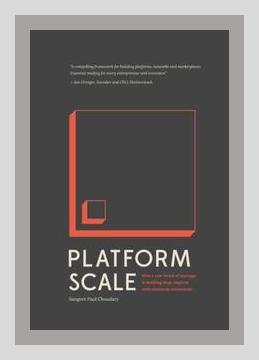Entrepreneurship and StartupsBusiness Models
“Platform Scale: How an Emerging Business Model Helps Startups Build Large Empires with Minimum Investment” by Sangeet Paul Choudary is a comprehensive guide on how platforms have revolutionized traditional business models by leveraging network effects, minimal investments, and scalability. The book delves into the intricacies of building platform businesses and highlights the differences between traditional linear businesses and platform-based models. Here is a detailed summary based on the key concepts, rendered through various examples and actionable insights shared by Choudary:
Introduction to Platform Scale
Key Concept: The transition from linear to platform models.
– Example: Traditional businesses like Ford, a car manufacturer, follow a linear supply chain involving production and then distribution. In contrast, Uber, a platform business, creates a marketplace for drivers to connect with passengers, both of whom co-create value on the platform.
Actionable Insight: To leverage a platform business model, one should identify areas where users can interact directly with each other, creating mutual value without heavy initial investments.
Elements of Platform Scale
Key Concept: The core elements of a scalable platform include the ecosystem, producers, consumers, and value units.
– Example: Airbnb operates by creating an ecosystem where homeowners (producers) can connect with travelers (consumers) to rent spaces (value units).
Actionable Insight: Focus on establishing a clear ecosystem outlining who the producers and consumers are and defining the transactional value units that are exchanged.
Network Effects
Key Concept: Positive network effects increase the platform’s value as more users join.
– Example: Facebook’s value increases as more users join and interact, leading to higher engagement and more data for targeted advertising.
Actionable Insight: Enhance user interaction by incorporating features that encourage sharing and collaboration, thereby amplifying network effects.
Building and Governing the Platform
Key Concept: The role of the platform owner is to facilitate interactions, set rules, and enforce governance.
– Example: eBay structures its platform to allow buyers and sellers to interact, but also enforces strict rules on transactions to ensure trust and reliability.
Actionable Insight: Develop a robust governance framework that includes user guidelines, dispute resolution mechanisms, and quality control measures to maintain trust on the platform.
Plug-and-Play Model
Key Concept: Platforms should be designed to integrate easily with other platforms and services.
– Example: Apple’s App Store allows developers to create third-party applications on iOS, adding tremendous value to the iPhone and iPad ecosystems.
Actionable Insight: Create APIs and development kits that allow external developers to build on the platform, thereby enhancing functionality and user engagement.
Building Critical Mass
Key Concept: Achieving critical mass is essential for sustaining platform growth.
– Example: WhatsApp achieved critical mass by focusing on ease of use and no-cost messaging, quickly attracting a large user base that established it as the go-to messaging app.
Actionable Insight: Identify and prioritize features that lower barriers to entry and accelerate user acquisition to reach a critical mass of users quickly.
Monetization Models
Key Concept: Platforms can employ various monetization strategies such as transaction fees, subscription, or advertising.
– Example: LinkedIn uses a mix of subscription fees (LinkedIn Premium), advertising, and recruitment solutions as its monetization strategies.
Actionable Insight: Experiment with different monetization models to find the one that aligns best with the platform’s value proposition and user behavior.
Trust and Safety Mechanisms
Key Concept: Ensuring trust and safety is paramount for platform success.
– Example: Airbnb employs verification processes, user reviews, and a secure payment system to build trust among users.
Actionable Insight: Implement verification processes, create rating and review systems, and ensure secure transactions to build a trustworthy platform environment.
Data Liquidity
Key Concept: The seamless flow of data across the platform enhances user experience and value creation.
– Example: Google Search processes huge amounts of query data to constantly improve its search algorithms, providing more accurate and reliable search results.
Actionable Insight: Invest in data analytics and ensure that data generated from user interactions is leveraged to enhance platform services and user personalization.
Openness and Control
Key Concept: Balancing openness for innovation and control for security and quality.
– Example: Wikipedia allows open editing of articles but maintains editorial guidelines and active monitors to ensure content accuracy.
Actionable Insight: Strive for a balance where the platform remains open to contributions and innovations but also implements controls to maintain quality and security.
Conclusion: Future of Platforms
Key Concept: Platform models will continue to disrupt traditional businesses.
– Example: Amazon leverages its platform to branch out into various sectors, including cloud computing (Amazon Web Services), logistics, and even physical retail.
Actionable Insight: Continuously explore new areas for platform expansion and be prepared to pivot and adapt to market changes and technological advancements.
Reflection on Key Points and Further Actionable Strategies
-
Ecosystem Mapping: Sketch a comprehensive map of your platform ecosystem, listing all stakeholders, their roles, and the value they exchange. This visualization aids in identifying strengths, weaknesses, gaps, and opportunities for platform enhancement.
-
User Incentives: Develop incentive structures for early adopters and highly active users. Reddit’s karma system rewards user contributions, enhancing engagement.
-
Collaborative Filtering: Employ collaborative filtering techniques to personalize user experiences. Netflix tailors viewing recommendations based on user behavior, increasing engagement and satisfaction.
-
Feedback Loops: Establish continuous feedback loops. Use surveys, user interviews, and data analytics to gauge user sentiment and adapt your platform iteratively.
-
Scalability Testing: Perform stress tests and scalability assessments to ensure your platform can handle an increasing number of users without degradation in performance or user experience.
-
Community Building: Foster user communities around shared interests or values. Platforms like Stack Overflow thrive due to strong community engagement centered around knowledge sharing.
By integrating these strategies, one can effectively navigate the detailed journey Choudary outlines for creating, scaling, and sustaining successful platform businesses. This summary encapsulates the essence of the book “Platform Scale” while providing actionable steps aligned with the author’s insights, making it a valuable resource for anyone interested in modern business models.
